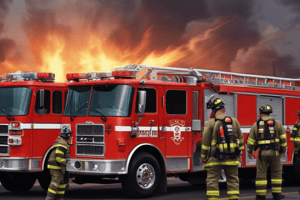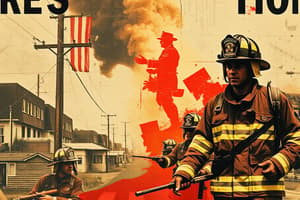Podcast
Questions and Answers
Who holds the primary responsibility for ensuring the station is prepared for severe weather events?
Who holds the primary responsibility for ensuring the station is prepared for severe weather events?
- EMS Officer
- Dispatch Operator
- Fire Chief
- Shift Commander and Company Officer (correct)
What specific aspect of the station needs to be cleaned to ensure preparedness for severe weather events?
What specific aspect of the station needs to be cleaned to ensure preparedness for severe weather events?
- Office spaces
- Apparatus bays
- Gutters of all stations (correct)
- Personal lockers
What should be confirmed regarding the department's portable pumps?
What should be confirmed regarding the department's portable pumps?
- Financial cost
- Availability, location, and operational status (correct)
- Ownership
- Insurance coverage
What should be obtained and confirmed for effective emergency preparedness?
What should be obtained and confirmed for effective emergency preparedness?
What essential medical supplies must be reviewed and replaced or filled as necessary before severe weather events?
What essential medical supplies must be reviewed and replaced or filled as necessary before severe weather events?
Where should the Disaster Operations Board be installed?
Where should the Disaster Operations Board be installed?
What should be made available to all stations when the strike probability is greater than 50%?
What should be made available to all stations when the strike probability is greater than 50%?
Where should Flood Zone Maps be posted throughout the district?
Where should Flood Zone Maps be posted throughout the district?
Who will meet with the Shift Commander and Company Officers to review disaster response procedures?
Who will meet with the Shift Commander and Company Officers to review disaster response procedures?
What should be reviewed regarding the chain-of-command during severe weather events?
What should be reviewed regarding the chain-of-command during severe weather events?
What should facilities with special needs populations have in place?
What should facilities with special needs populations have in place?
Who is responsible for providing evacuations to emergency shelters?
Who is responsible for providing evacuations to emergency shelters?
What should be done when sustained winds of 50 mph or greater are attained?
What should be done when sustained winds of 50 mph or greater are attained?
Study Notes
Responsibilities for Weather Preparedness
- Shift Commander and Company Officer are responsible for station readiness during severe weather events.
- Before severe weather, check and fuel generators, apparatus, small engines, and tools to ensure operational capability.
Pre-Storm Preparations
- Secure BBQ grills, outdoor furniture, and station flags in anticipation of storms.
- Clean gutters of all stations to prevent flooding and ensure drainage.
- Confirm availability, location, and operational status of portable pumps for emergency response.
- Obtain emergency contact numbers for Department of Public Works (DPW), utilities, and other agencies for coordination.
Equipment and Supplies Readiness
- Review and ensure batteries for flashlights, portable radios, pagers, and CO monitors are functional.
- Medical supplies and inventory, including oxygen, should be checked and replenished as necessary.
- Fill and install sand barrels, plows, and ballast on department vehicles for adverse conditions.
Emergency Resources and Protocols
- The Disaster Operations Board should be located in the Station 1 kitchen/hallway for easy access.
- Keep snow shovels on apparatus for efficient snow removal when needed.
- Dispatch must check the supply of forms, backup phones, and incident sheet holders for operational continuity.
Emergency Protocols During Severe Weather
- Distribute emergency preparedness handouts to all stations when severe weather strike probability exceeds 50%.
- Flood Zone Maps should be posted in three post offices, three district libraries, and all fire stations for public awareness.
- Emergency shelter kits must include Sign-In & Out forms, a flashlight, a first aid kit, a portable radio with charger, and an AED.
Chain-of-Command and Community Support
- Review and designate division leaders and areas of responsibility in the chain of command during severe weather emergencies.
- Facilities with special needs populations need specific plans and resources for emergency evacuation.
- Barnstable Police, alongside the Barnstable County Sheriff's Office, will handle evacuations to emergency shelters during severe weather.
Response Protocols Based on Wind Speeds
- When sustained winds reach 50 mph, initiate a restricted response, refraining from non-emergency calls.
- If winds reach 70 mph, evaluate calls based on hazard level and life safety before responding.
- Chief Officers must determine when it becomes too dangerous for fire department operations during storms.
Incident Management and Coordination Post-Storm
- If station doors are blocked by heavy debris, obtain assistance with appropriate equipment for quick clearance.
- During incidents of arcing wires or fallen wires, use hazard tape and road closures to manage units for safety.
- Coordinate with assisting agencies post-storm for road clearing and accountability of evacuees in impacted areas.
Studying That Suits You
Use AI to generate personalized quizzes and flashcards to suit your learning preferences.
Description
Test your knowledge on the procedures for handling weather disaster events specifically for fire departments. This quiz covers responsibilities, equipment readiness, and safety measures essential for severe weather events. Ensure your station is always prepared and ready to respond effectively.




